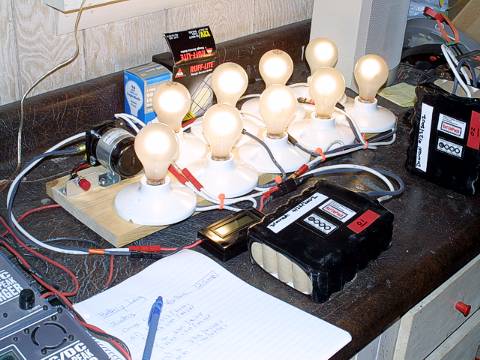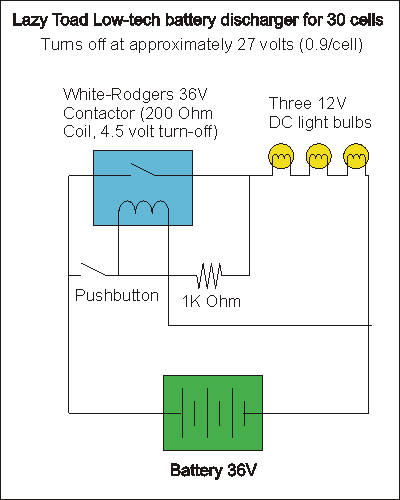




If you read tips on taking care of your Nicad and Nickel-Metal hydride batteries, such as The Care and Feeding of NiCd Batteries by Dennis Clark, you'll often read statements like: "discharge your batteries to 0.9 volts per cell." That's because you do want to store your Nicads "empty", but you don't want to take your pack down to 0 volts. Individual cells can be safely taken to 0 volts with a small resistor. Packs of cells in series cannot; the weakest cell will go to zero first, then the other cells will try to reverse charge it. This destroys the weak cell and renders the pack useless. So stopping at 0.9 volts per cell is really important.
There are two parts to this instruction. First, you must have a place to put the energy; typically lightbulbs are used. Second, you need a way to stop taking energy out once the voltage drops to a given level.
Steve Hill gave me a great tip at TI-3...R/C car buffs sometimes use fans instead of lightbulbs to sink the voltage...that seems like a good idea on a hot day.
Commonly available R/C car battery dischargers work on single packs of between 4 and 10 cells, so I was left building one myself. Automotive supplies, boat stores, and harward stores sell 50W 12V DC bulbs with a standard base, so the "dump" part was easy.
I started thinking about voltage comparators and relays to turn the device off, then I realized that since I needed a relay anyway, I could just use the relay to sense when the voltage dropped. A simple voltage divider circuit made with a small resistor allows the cutoff voltage to be set.

I built a light board with 9 bulbs connected by Powerpole connectors, so I can rewire the board without unscrewing anything. For a 12 amp drain at 36 volts, I wire nine 50 watt 12 volt DC bulbs into 3 parallel strings of 3 bulbs in series. For a 4 amp drain, I just unhook two of the three strings.
To use it, just plug the battery pack into the circuit (either direction...talk about low tech), and push the start button. That energizes the relay and turns on the lights. Now let go of the button and the lights stay on until the voltage across the relay coil drops. In this case the 1,000 Ohm resistor is in series with the 200 Ohm relay coil, so the relay only sees 1/6 of the voltage. Our target cutoff is 30 cells times 0.9 volts, or 27 volts, and this setup in my garage cuts off between 26.7 and 27.2 volts.
You can use the same idea and different resistors in your garage to work with different relays and different sized battery packs.
Of course, this device just removes the energy and stops at the right point. What we really want is a fancy digital readout of performance. But since Astroflight makes a really cool Whatt Meter ($59.95), all we have to do is hook the battery to the Whatt-meter, hook the Whatt Meter to the discharger, and voila!, we can safely discharge our 36 volt BattlePacks and get a reading of how much energy they put out.

 Here we see that a 36 volt BattlePack has provided 3.5 amp hours, and
during the discharge, it was providing 12.6 amps (a stopwatch tells us the lights went out at 16 minutes and
48 seconds). Note that the voltage provided by the Nicads has rebounded to almost 36 volts, even though this
pack is effectively empty. That's why you can't use a volt meter to measure how much charge is in a
Nicad battery.
Here we see that a 36 volt BattlePack has provided 3.5 amp hours, and
during the discharge, it was providing 12.6 amps (a stopwatch tells us the lights went out at 16 minutes and
48 seconds). Note that the voltage provided by the Nicads has rebounded to almost 36 volts, even though this
pack is effectively empty. That's why you can't use a volt meter to measure how much charge is in a
Nicad battery.
All with a push button switch, a resistor, and a relay that was sitting around gathering dust.